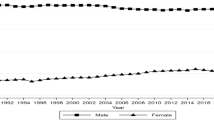Abstract
This study uses data on 229 organizers from eight unions to assess differences in characteristics of organizers employed by manufacturing and service unions. The results suggest that a new breed of organizer is entering the labor movement through service unions-organizers who are younger, more highly educated, more socially mobile, and have less experience in the union movement than organizers from manufacturing unions.
Similar content being viewed by others
References
American Federation of Labor and Congress of Industrial Organizations.The Changing Situation of Workers and Their Unions: A report of the AFL-CIO Committee on the Evolution of Work. Publication No. 165. Washington, DC: AFL-CIO, 1985.
Block, Richard N. and Jack Stieber. “The Impact of Attorneys and Arbitrators on Arbitration Awards.”Industrial and Labor Relations Review 40 (1987): 543–55.
Chaison, Gary N. and P. Andiappan. “Profiles of Local Union Officers: Females v. Males.”Industrial Relations 26 (1987): 281–83.
Fiorito, Jack and Wallace E. Hendricks. “Union Characteristics and Bargaining Outcomes.”Industrial and Labor Relations Review 40 (1987): 569–84.
Getman, Julius G. “Ruminations on Union Organizing in the Private Sector.”The University of Chicago Law Review 53 (1986): 45–77.
Hoyman, Michele M. and Lamont Stallworth. “Participation in Local Unions: A Comparison of Black and White Members.”Industrial and Labor Relations Review 40 (1987): 323–35.
Kahn, Shulamit, Kevin Lang, and Donna Kadev. “National Union Leader Performance and Turnover in Building Trades.”Industrial Relations 25 (1986): 276–91.
Karsh, Bernard, Joel Seidman, and Daisy M. Lilienthal. “The Union Organizer and His Tactics: A Case Study.”American Journal of Sociology 59 (1953): 113–22.
Kochan, Thomas A., ed.Challenges and Choices Facing American Labor. Cambridge, MA: MIT Press, 1985.
Lewin, David and Peter Feuille. “Behavioral Research in Industrial Relations.”Industrial and Labor Relations Review 36 (1983): 341–60.
Maddala, G.S.Limited-Dependent and Qualitative Variables in Econometrics. New York: Cambridge University Press, 1983.
Maranto, Cheryl L. and Jack Fiorito. “The Effect of Union Characteristics on the Outcome of NLRB Certification Elections.”Industrial and Labor Relations Review 40 (1987): 225–40.
McKersie, Robert and Montague Brown. “Nonprofessional Hospital Workers and a Union Organizing Drive.”Quarterly Journal of Economics 77 (1963): 372–404.
Perkel, George. “The Failure of Communication in an Organizing Campaign.”Monthly Labor Review 80 (1957): 1200–1201.
Petersen, Trond. “A Comment on Presenting Results from Logit and Probit Models.”American Sociological Review 50 (1985): 130–31.
Reed, Thomas F. “Union Attainment of First Contracts: Do Service Unions Possess A Competitive Advantage?”Journal of Labor Research (Fall 1990a).
_____. “Do Union Organizers Matter?: Individual Differences, Campaign Practices, and Representation Election Outcomes.”Industrial and Labor Relations Review 43 (1989a): 103–19.
_____. “Union Organizing Department Characteristics and Representation Campaign Tactics.” Working Paper. Department of Management, Texas A&M University, College Station, 1989b.
_____. “Nice Guys Don’t Always Finish Last: The Impact of the Union Organizer on the Probability of Securing a First Contract.”Industrial Relations (1990b).
U.S. Equal Employment Opportunity Commission.Job Classification Guide. Office of Program Research, Survey Division. Washington, D.C.: U.S. Equal Employment Opportunity Commission, 1985.
Author information
Authors and Affiliations
Additional information
This article is based on data collected for a dissertation written at the Graduate School of Business at Columbia University. I gratefully acknowledge the support of committee members David Lewin, James Kuhn, Casey Ichniowski, and Seymour Spilerman of Columbia and Charles A. O’Reilly III of the University of California at Berkeley. I thank John Delaney for his many helpful insights and suggestions during the course of my research and Shannon Ratcliff and Rick Fuentes for comments on an earlier draft of this paper. This research was financially supported by the Industrial Relations Research Center and the Management Institute at Columbia University and the Department of Management at Texas A&M University.
Rights and permissions
About this article
Cite this article
Reed, T.F. Profiles of union organizers from manufacturing and service unions. Journal of Labor Research 11, 73–80 (1990). https://doi.org/10.1007/BF02685421
Issue Date:
DOI: https://doi.org/10.1007/BF02685421




